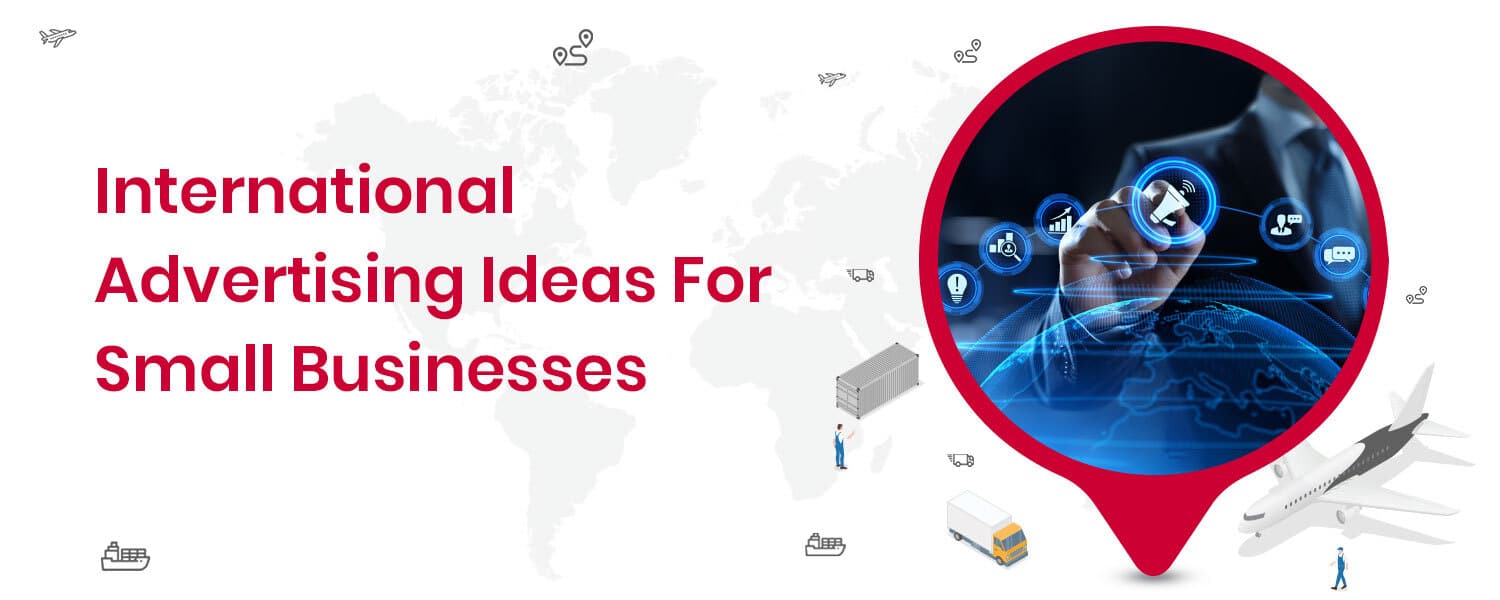International marketing and advertising are no longer reserved for brands with deep pockets, nor is it a huge hassle for marketing managers who handle all advertising efforts. In fact, a global presence is possible for any business with a creative strategy and an understanding of world markets. From learning new techniques and improving your business targeting to gaining more customers in a larger market, there are various reasons why going international could be a wise choice for your small business’s advertising.
Use this helpful guide to learn about available options and decide which is best for your business.
Cost-Effective Small Business Advertising Ideas
When you run a business in a competitive industry like eCommerce, having a good product is not enough, you also have to take it in front of customers. That’s why marketing and advertising have become very important. But you would agree that small businesses often have a tight marketing budget to spend or sometimes no budget to work with. In addition, not everyone can hire a digital marketing agency or a marketing executive to do advertising for their product. Still, thankfully, there are plenty of cost-effective advertising ideas for small businesses that require less or no money.
These marketing and advertising ideas are as effective as big-budget advertising campaigns but will not break the bank. So in this post, we’ve compiled free and low-budget advertising ideas for you.
Free And Fast Marketing Ideas
1. Create A Free Google My Business Account
One of the easiest and most effective ways to boost your eCommerce business is by setting up a free Google My Business account. Google My Business is a tool that allows you to manage your business’s online presence across Google, especially in local searches and maps. By setting up a Google My Business account, you’ll be able to appear in Google Maps, local search results, and the knowledge panel when people search for products or services like yours. For eCommerce starters, it can help you increase your visibility in local search results, making it more likely that people in your area will find your business. Additionally, it allows you to show off your products and services, post updates and offers, and connect with potential customers through reviews.
Here is a step-by-step guide on how to set up one:
- Go to https://www.google.com/business/
- Click on “Manage now.”
- Sign in with your Google account or create one if you don’t have one
- Fill out your business name, address, and phone number, and select your business category
- Verify your business by mail or phone
2. Post (And Engage) On Social Media
Let’s be real; social media is where eCommerce businesses are nowadays. With billions of people scrolling through their feeds every day, it’s a no-brainer not to have a strong presence on social media to reach your target audience.
- First things first, choose the platforms that make the most sense for your business. If you’re selling fashion, then Instagram and Pinterest should be at the top of your list. And if you’re selling to consumers, Facebook and Twitter are great options.
- Now that you’ve chosen your platforms, it’s time to get creative and post engaging content. And when we say engaging, we mean posts that will make people stop scrolling and pay attention. Think visually stunning product shots, behind-the-scenes content, and customer testimonials.
- Don’t just post and run; social media is all about engagement. So make sure you respond to comments, direct messages, and reviews. This will show your followers that you’re paying attention and caring about them.
- Have fun with it, be relatable, and show your brand personality because no one wants to follow a boring account.
3. Tag People (And Brands) On Social Media
Tagging people and brands on social media is a great way to increase the visibility and reach of your posts. Tagging is a feature that allows you to mention or identify other users or brands within your post. This helps to increase the visibility of your post, as it will be seen by the users and brands you tag, as well as their followers. For example, when you tag a brand or influencer in your post, they are more likely to see and engage with it, which can lead to increased engagement and reach for your post.
Here are a few tips to keep in mind:
- Only tag relevant people and brands.
- Always ask for permission before tagging someone or a brand in a post.
- Use tags in the caption or comments of your post instead of the image itself.
- Use tags sparingly. Too many tags can make your post look spammy.
4. Use Hashtags!
Hashtags are a powerful tool that can help you increase the visibility and reach of your social media posts. When you include a hashtag in your post, it becomes searchable and discoverable by other users searching for it. Using hashtags effectively is all about ensuring that you’re using relevant and popular hashtags to help you reach your target audience. Here are a few tips to keep in mind:
- Use specific and relevant hashtags that relate to your post.
- Use a mix of popular and niche hashtags to reach a broad and targeted audience.
- Keep track of the hashtags performing well for your business and use them consistently.
- Avoid using too many hashtags in one post. It can make it look spammy.
5. Don’t Sleep On LinkedIn
LinkedIn is the social media platform for intellectuals that is often overlooked by businesses, but it should not be underestimated. It is a powerful tool that can help you expand your business’s reach and visibility and build relationships with potential customers and partners.
LinkedIn has a more professional business-oriented audience and is more likely to be decision-makers and influencers in their respective companies. As a result, it is a great place to network, establish thought leadership, and generate leads. By having a strong presence on LinkedIn, you can position your business as a trusted and credible resource in your industry.
Free Marketing Ideas That Require A Little More Effort
6. Do Some Local SEO
Local SEO is the process of optimizing your eCommerce website and online presence to rank higher in local search results. Local SEO is important for eCommerce businesses that rely on customers in a specific geographic location to drive sales and revenue. By optimizing your website and online presence for local search, you can increase your business’s visibility to potential customers searching for products or services like yours in your area.
To optimize your eCommerce website and online presence for local SEO, here are a few tips to keep in mind:
- Make sure your business name, address, and phone number are consistent across all online platforms.
- Encourage customers to leave reviews on popular sites like Google and other review websites.
- Optimize your website’s meta tags, Google My Business, and content for local search keywords.
- Add location pages or service area pages to your website. This will help search engines understand the areas you serve.
7. Develop An Email Marketing Plan
Email marketing is an effective way for eCommerce businesses to reach and engage with their target audience, promote their products and services, and ultimately drive sales and revenue. Email marketing allows you to reach a large audience simultaneously with a high level of personalization and automation.
To create an effective email marketing strategy for your eCommerce business, here are a few tips to keep in mind:
- Segment your audience: Divide your email list into segments based on demographics, purchase history, and other criteria.
- Personalize your emails: Use the recipient’s name, purchase history, and other data to make your emails more personalized and relevant.
- Use a clear call-to-action: Make it easy for your subscribers to take the next step: purchase a product or sign up for a newsletter.
- Test and optimize: Test different subject lines, email content, and call-to-actions to see what works best for your audience. Use this data to optimize your email campaigns and improve their effectiveness over time.
8. Create Data-rich Infographics
Infographics allow you to present complex data, statistics, and information in an easy-to-understand and visually appealing format. Infographics are a great way to capture your audience’s attention, break down complex information, and make your content more shareable through visual storytelling and content marketing. They can help to increase engagement, drive traffic, and generate leads.
To create compelling infographics that engage and inform, here are a few tips to keep in mind:
- Keep it simple: Avoid cluttering your infographic with too much text or data.
- Use visuals to tell a story: Use charts, graphs, and other visuals to make your data more engaging and easy to understand.
- Use contrasting colors: Use contrasting colors to make your data stand out and make it easy to read.
- Optimize for social media: Make sure your infographic is optimized for social media and can be easily shared.
9. Claim Free Ad Promo Credits
Many platforms, such as Google and Facebook, offer free ad credits to new advertisers or businesses that meet certain criteria. You may also be able to find promos by searching online, and some website hosting services offer advertising discount codes as a part of their services. Once you find an offer, you will typically need to create an account and provide payment information to redeem the credit.
10. Apply For Business Awards
Applying for business awards can be an effective way to boost your visibility and credibility as a business. Awards can help to establish your business as an industry leader and recognize your achievements. In addition, winning an award can provide third-party validation of your products, services, and overall business performance, which can help to attract new customers and partners.
When it comes to leveraging your award wins to promote your business, you can use the award logo and mention the award on your website, business cards, and other marketing materials. In addition, share the news of your award win on social media and other online platforms.
11. Feeling Brave? Give Guerilla Marketing A Try
Give guerilla marketing a try. It’s all about getting creative and thinking outside of the box. Guerrilla marketing is an unconventional and often unexpected marketing strategy that aims to grab the attention of a target audience in a creative and memorable way. It’s all about standing out from the crowd and creating a buzz.
Some examples of successful guerrilla marketing campaigns include:
- A clothing brand was setting up a pop-up shop in a busy city centre, giving away free samples and discounts to attract customers.
- An energy drink company created a flash mob to promote its product in a busy shopping mall.
- A tech company using augmented reality to create a virtual scavenger hunt in a popular park.
12. Publish Great Content
We all know the saying “content is king,” and for a good reason. Content marketing is a powerful way for businesses to reach and engage with their target audience, establish thought leadership, and ultimately drive sales and revenue. By creating high-quality content that resonates with your audience, you can attract and retain customers and set yourself apart from the competition.
But not all content is created equal, and publishing just any old thing isn’t going to cut it. To create content that resonates with your audience, you’ll want to keep a few things in mind:
- Know your audience: Understand your target audience and what they are looking for.
- Be informative and useful: Your content should be informative and useful to your audience.
- Be consistent: Regularly publishing high-quality content will help establish you as an authority in your industry.
- Be shareable: Make it easy for people to share your content on social media and with others.
13. Start A Blog
Starting a blog is the easiest, most low-cost, and a powerful way for businesses to establish leadership and attract and engage with their target audience. Blogging allows you to share your expertise, insights, and knowledge on industry-specific topics and to connect with your audience on a more personal level.
14. Form Industry Partnerships
Forming industry partnerships is a powerful way for businesses to expand their reach and access new resources. You can leverage their networks, expertise, and resources to achieve your business goals by partnering with other businesses.
To identify and approach potential partners, here are a few tips to keep in mind:
- Identify your goals: Understand what you want to achieve through your partnerships.
- Research potential partners: Look for businesses that have complementary products, services, or audiences.
- Connect on a personal level: Reach out to potential partners on a personal level and try to establish a connection.
- Be clear about what you can offer: Be clear about what you can offer the potential partner and how the partnership will be mutually beneficial.
15. Post Helpful Videos
Posting helpful videos is a great strategy to target an audience and establish leadership. The power of video marketing lies in its ability to tell stories and convey information in a visually engaging way. Creating and distributing engaging and informative videos will help you capture your audience’s attention and make your content more shareable.
16. Turn Employees Into Brand Ambassadors
Employee advocacy is about empowering and encouraging employees to share your brand message with their networks and communities. The benefits of employee advocacy are numerous. First, it allows you to tap into your employees’ networks, reach new audiences, and establish your brand as credible and trustworthy in the eyes of your customers.
To encourage and empower your employees to share your brand message, here are a few tips to keep in mind:
- Provide your employees with the tools and resources to share your brand message.
- Provide incentives for your employees to participate in employee advocacy.
- Encourage your leadership team to participate in employee advocacy.
- Provide training and support to help your employees understand your brand message and how to share it effectively
17. Recycle Your Old Content
Recycling your old content gives more mileage out of your marketing efforts. Repurposing old content allows you to update and republish content that is still valuable and relevant without starting from scratch. It’s a cost-effective way to keep your content fresh and engage your audience. First, use tools like Google Analytics to identify your most popular and engaging content and Identify any gaps in your content that you can fill with updated or repurposed content. Then, make sure the content is still relevant and up-to-date.
When it comes to republishing and repromoting old content, here are a few strategies to keep in mind:
- Update the content with new information, statistics, or examples.
- Republish the content on different platforms, such as your website, social media, or email marketing.
- Repurpose the content into different formats, such as videos, infographics, or podcasts.
- Promote the updated content again to reach new audiences or remind your existing audience about it.
18. Host A Social Media Contest Or Giveaway
Hosting a social media contest or giveaway to promote your business increases engagement and reach and drives sales. Contests and giveaways are fun and interactive to create buzz around your brand and attract new customers.
When creating a contest or giveaway, here are a few tips to keep in mind:
- Keep your contest or giveaway simple and easy to enter.
- Make sure your contest or giveaway is relevant to your target audience.
- Be creative and think outside the box.
- Make sure your contest or giveaway complies with all the rules and regulations of the social media platform you are using.
19. Set Up A Customer Referral Program
Setting up a customer referral program can attract new customers. Referral programs are all about leveraging the power of word-of-mouth marketing and incentivizing current customers to refer their friends, family, and acquaintances to your business. Having a referral program or affiliate program is the same as word-of-mouth marketing. Promoters through content marketing refer your product to their audience, which is four times more likely to buy.
20. Run A Facebook Campaign
Running a Facebook campaign can be a great way for businesses to promote their brand, increase reach and engagement, and ultimately drive sales and revenue. Facebook advertising allows you to target specific audiences, track the performance of your ads, and adjust your strategy accordingly. Promoting your brand and increasing reach and engagement is the best way. Facebook advertising allows you to target specific audiences, increasing the chances of reaching your desired audience, and also provides measurable results to track the performance of your ads and adjust your strategy accordingly.
When creating Facebook ads, use visuals such as images and videos to make your ads more engaging and have a clear call to action in your ads, such as “Learn More” or “Sign Up Now.” Use A/B testing to test different versions of your ads and see which ones perform best.
Free And Low-Budget Small Business Marketing Ideas [Summary]
With the help of the above marketing strategies and ideas, small eCommerce businesses can reach out to a wide audience, establish a strong brand presence, and build trust with their customers. Marketing and advertising are important, but you don’t have to spend millions on them. Remember, if your product is good and genuinely solves customers’ problems, it will be bought by customers.




